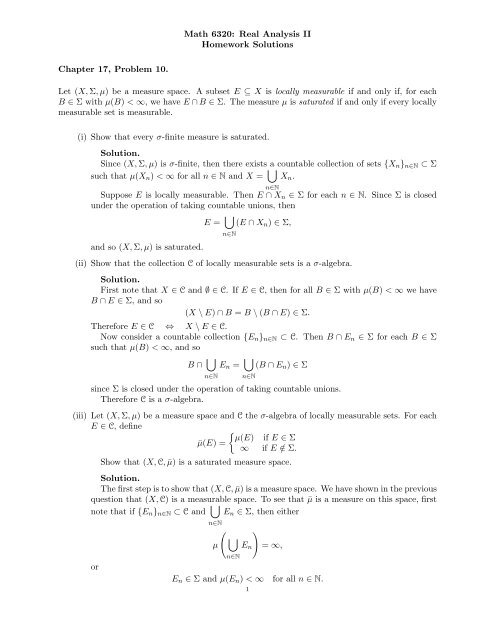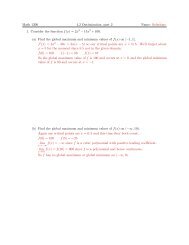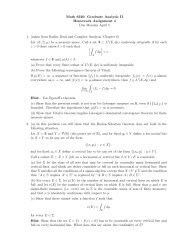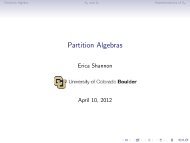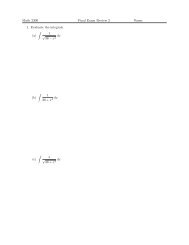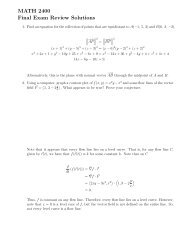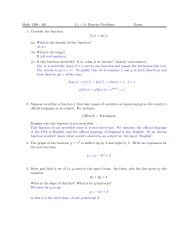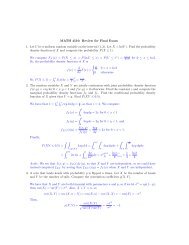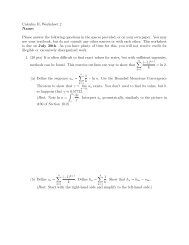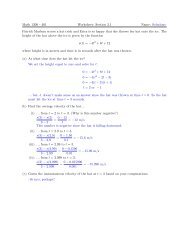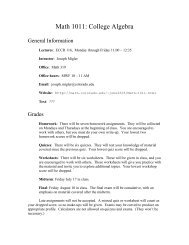Math 6320: Real Analysis II Homework Solutions Chapter 17 ...
Math 6320: Real Analysis II Homework Solutions Chapter 17 ...
Math 6320: Real Analysis II Homework Solutions Chapter 17 ...
Create successful ePaper yourself
Turn your PDF publications into a flip-book with our unique Google optimized e-Paper software.
Suppose (for contradiction) that this is not the case. Then( ) ⋃µ E n < ∞n∈Nand E N /∈ Σ for some N. Then, since E N ∈ C, ⋃ ( ) ⋃E n ∈ Σ and µ E n < ∞, we haven∈N n∈NE n = E n ∩ ⋃ n∈NE n ∈ Σ,a contradiction. Therefore, we have countable monotonicity of ¯µ, and(a) ¯µ(∅) = 0 and ¯µ(E) ≥ 0 for all E ∈ C, and(b) for any countable collection of disjoint sets {E n } n∈N ⊂ C, we have( ) ⋃E nn∈N¯µ= ∑ n∈N¯µ(E n ).Now suppose that E is locally measurable with respect to (X, C, ¯µ), i.e. E ∩ B ∈ C foreach B ∈ C with ¯µ(B) < ∞. The condition ¯µ(B) < ∞ implies that B ∈ Σ and µ(B) < ∞.Moreover, E ∩ B ∈ C implies that ¯µ(E ∩ B) ≤ ¯µ(B) < ∞, by monotonicity of ¯µ. ThereforeE ∩ B ∈ Σ also, and so E is locally measurable with respect to (X, Σ, µ). Therefore E ∈ C,which completes the proof.(iv) Now suppose in addition that µ is semifinite. For each E ∈ C, defineµ(E) = sup {µ(B) : B ∈ Σ, B ⊆ E} .Show that (X, C, µ) is a saturated measure space and that µ is an extension of µ. Givean example to show that ¯µ and µ may be different.Solution.Again, we know that (X, C) is a measurable space, and we first have to show that(X, C, µ) is a measure space.Clearly µ(∅) = 0 and µ(E) ≥ 0 for all E ∈ C, and so it remains to show that µ iscountably additive.To see this, let {E k } k∈N ⊂ C be a countable collection of disjoint, locally measurablesubsets of X.Superadditivity of µ follows from the definition of µ using the supremum (without usinglocal measurability). To see this, given any ε > 0, for each k ∈ N there exists B k ∈ Σ suchthat µ(E k ) ≤ µ(B k ) + ε . Therefore2 k∑µ(B k ) + εµ(E k ) ≤ ∑k∈N k∈N( ) ⋃B kk∈N= µ≤ µ( ⋃k∈NE k)+ ε (by countable additivity of µ)+ ε (since ⋃ k∈NB k ⊆ ⋃ k∈NE k ).This is true for all ε > 0, and so( )∑⋃µ(E k ) ≤ µ E k .k∈Nk∈N
To see the opposite inequality, suppose first that µ( ⋃k∈NE k)< ∞ Note that by definitionof µ using the supremum, for all ε > 0 there exists a set B ∈ Σ such that B ⊆ ⋃ k∈NE kandµ( ⋃k∈NE k)≤ µ(B) + ε.Countable additivity of µ shows that we also have( )⋃(1) µ(B) = µ (B ∩ E k ) = ∑ µ(B ∩ E k ) ≤ ∑ µ(E k ),k∈Nk∈Nk∈Nwhere we use the fact that B ∩ E k ∈ Σ since each E k is locally measurable. Therefore, wehave shown that( ) ⋃E kk∈Nfor each( ε > 0. ) ⋃E kk∈NIf µµ≤ ∑ k∈Nµ(E k ) + ε= ∞, then, since µ is semifinite, we know that for all N there exists Bwith µ(B) > N. The inequality (1) still holds, and so ∑ k∈Nµ(E k ) + ∞ also.Therefore, we have shown that µ is countably subadditive on disjoint collections of setsin C.Combining the two inequalities shows that µ is countably additive.Now it remains to show that if E is locally measurable with respect to (X, C, µ), thenE ∈ C.If E is locally measurable, then E∩B ∈ C for all B ∈ C such that µ(B) < ∞. We want toshow that E ∩A ∈ Σ for all A ∈ Σ such that µ(A) < ∞. Given A ∈ Σ such that µ(A) < ∞,note that µ(A) < ∞ also, and so E ∩ A ∈ C. Since C is the collection of sets that arelocally measurable with respect to (X, Σ, µ) and µ(A) < ∞, then E ∩ A = E ∩ A ∩ A ∈ Σ,which shows that E ∈ C.Finally, to show that µ ≠ ¯µ in general, consider the following example.Let X be the two point space X = {a, b}, let Σ = {∅, X}, and let µ(∅) = 0, µ(X) = ∞.Then {a} and {b} are locally measurable, since the only set of finite measure is the emptyset, and so {a} ∩ ∅ = ∅ ∈ Σ, and similarly for {b}. Therefore C is the power set on twoelements. The two extensions are thenµ({a}) = 0, µ({b}) = 0¯µ({a}) = ∞, ¯µ({b}) = ∞.Note that µ is still a measure, even though µ is not semifinite.It turns out (see the previous edition of Royden) that there is still a smallest extensionµ of µ to C, even if µ is not semifinite.<strong>Chapter</strong> 18, Problem 13.Let {f n } be a sequence of real-valued measurable functions on X such that, for each n ∈ N({µ x ∈ X : |f n (x) − f n+1 (x)| > 1 })2 n < 12 n .Show that {f n } is pointwise convergent µ-a.e. on X.
Solution.First, recall the followingLemma 0.1 (Borel-Cantelli). Let (X, Σ, µ) be a measure space, and {E n } n∈N a countable collection∞∑of measurable sets for which µ(E n ) < ∞. Then µ-almost all x in X belong to at most a finitenumber of the E n ’s.n=1Note also that, given x ∈ X, if there exists N ∈ N such that |f n (x) − f n+1 (x)| ≤ 12 n for alln ≥ N, then {f n (x)} is Cauchy, since, for all M ∈ M such that M ≥ N, n, m ≥ M implies that|f n (x) − f m (x)| < 12 M−1 .Now letE n ={x ∈ X : |f n (x) − f n+1 (x)| > 12 n }.Then ∑ n∈Nµ(E n ) = 1 < ∞, and so the Borel-Cantelli lemma implies that µ-almost every x ∈ X liesin at most a finite number of the E n ’s. Therefore, for µ-almost every x ∈ X, there exists N suchthat |f n (x) − f n+1 (x)| ≤ 12for all n ≥ N. The above argument then shows that {f n n (x)} is Cauchy,and therefore convergent.Therefore, we have shown that the sequence {f n (x)} converges for µ-almost all x ∈ X.<strong>Chapter</strong> 18, Problem 16.Assume that µ(X) < ∞, and let {f n } be a sequence of functions on X. Show that f n → f inmeasure if and only if each subsequence of {f n } has a further subsequence that converges pointwiseµ-a.e. on X.Use this to show that for two sequences that converge in measure, the product sequence alsoconverges in measure to the product of the limits.Solution.First, we show that convergence in measure implies the existence of a subsequence {f nk } such thatf nk → f pointwise µ-a.e. on X. Recall that f n → f in measure if and only if for every ε, η > 0there exists N such thatµ ({x ∈ X : |f n (x) − f(x)| > η}) < ε.For each n, m ∈ N, defineE n,k ={x ∈ X : |f n (x) − f(x)| > 1 }2 k .Convergence in measure implies that for each k there exists N k such that n ≥ N k implies thatµ(E n,k ) < 1 for all n ≥ N2 k k . Therefore, there is an increasing sequence {n k } such that µ(E nk ,k)
To see the converse, let {f nk } be a subsequence of {f n }, and suppose that a further subsequencef nl converges to f pointwise µ-a.e. on X. Then Egoroff’s theorem shows that for each ε > 0, thesubsequence f nl converges uniformly outside a set of measure ε. Therefore f nl converges to f inmeasure.Now suppose (for contradiction) that {f n } does not converge to f in measure. Then there existη > 0 and ε > 0 such that for all k ∈ N there exists n k ≥ k such that(2) µ ({x ∈ X : |f nk (x) − f(x)| > η}) ≥ ε.Therefore, we can construct a subsequence {f nk } such that (2) holds. The above argument showsthat this subsequence has a further subsequence {f nl } that converges in measure to f, whichcontradicts (2), and so f n must converge to f in measure.Now suppose that f n → f and g n → g in measure. Then, given subsequences {f nk } and {g nk }, theabove result shows that there exist further subsequences {f nl } and {g nl } such that f nl → f andg nl → g pointwise µ-a.e. Therefore f nl · g nl → f · g pointwise µ-a.e., and so another application ofthe above result shows that f n · g n → f · g in measure.<strong>Chapter</strong> 18, Problem 32.∫Let f be integrable over X with respect to a measure µ. Show thatsubset E of X if and only if f = 0 µ-a.e. on X.Ef dµ = 0 for every measurableSolution.First note that if f = 0 µ-a.e. on X then we have X = X 1 ∪X 2 , where f = 0 on X 1 and µ(X 2 ) = 0.By definition∫f dµ =X∫f dµ +X 1∫f dµ = 0.X 2To see the converse, let P = {x ∈ X : f(x) ≥ 0} and N = {x ∈ X : f(x) < 0}. Then P and Nare measurable, and by assumption we have∫∫f dµ = 0, f dµ = 0.Chebyshev’s inequality shows that for each n ∈ N({µ x ∈ P : f(x) > 1 })nPN∫≤ n f dµ = 0.PTherefore, {x ∈ P : f(x) > 0} is the countable union of sets of measure zero, and therefore it alsohas measure zero.In a similar way, we can show that {x ∈ N : f(x) < 0} is also the countable union of sets ofmeasure zero.Therefore, f = 0 µ-a.e. on X.<strong>Chapter</strong> 18, Problem 39.Deduce Lebesgue’s Dominated Convergence Theorem from the Vitali Convergence Theorem.
Solution.Recall first the Vitali Convergence Theorem.Definition 0.2. (i) A collection F of measurable functions on (X, Σ, µ) is uniformly integrableif and only if for every ε > 0 there exists δ > 0 such that for all f ∈ F and E ∈ Σ,we have∫µ(E) < δ ⇒ |f| dµ < ε.(ii) The collection F is tight if and only if for every ε > 0 there exists a measurable set X 0 ∈ Σsuch that(a) ∫µ(X 0 ) < ∞, and(b) |f| dµ < ε for all f ∈ F.X\X 0Theorem 0.3 (Vitali). Let (X, Σ, µ) be a measure space, and {f n } a sequence of measurablefunctions on X that is both uniformly integrable and tight. Assume also that f n → f pointwiseµ-a.e. on X, and that f ∈ L 1 (X, µ). Then∫∫limn→∞XE|f n | dµ =Proposition <strong>17</strong> from <strong>Chapter</strong> 18 says that a collection F consisting of just one integrable functionis both uniformly integrable and tight. Therefore, given an integrable function g and a sequence{f n } such that |f n | ≤ g µ-a.e. on X, the collection F = {f n } n∈N is both uniformly integrable andtight, since∫ ∫|f| dµ ≤ g dµfor all E ∈ Σ, and, in particular,EEXf dµ.∫∫|f| dµ ≤ g dµ.X\X 0 X\X 0Now suppose that we also have f n → f pointwise µ-a.e. on X, and that f is measurable. Then|f| ≤ g µ-a.e. on X, so the Integral Comparison Test shows that f is also integrable. Vitali’sconvergence theorem then implies that∫ ∫limn→∞Xf n dµ =Xf dµ,which is the conclusion of Lebesgue’s Dominated Convergence Theorem.


